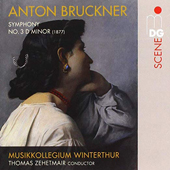

This is a lean and limber account of the 1877 version of the Symphony No. 3 in D minor by Anton Bruckner (1824-1896), with none of the brooding, ponderous, lightning bolts from heaven style of approach practised by many "Bruckner" conductors. Conductor (and acclaimed violinist) Thomas Zehetmair holds tight control on the orchestral forces, slightly favoring the strings but achieving precise timbral balance at all times. So when the brass sections come in, it doesn't feel like your sound system amplifier has suddenly gained an extra 100 watts of power. This is Zehetmair's first recording as principal conductor of the Musikkollegium Winterthur, the oldest orchestra in Switzerland, founded in 1875 as the Stadtorchester Winterthur. At around 50 musicians, it can easily outmanoeuvre the usually much larger orchestras typically used to perform Bruckner symphonies, which is what lends this recording a chamber-orchestra sound. The acoustics of the Winterthur church, where the recording took place, counteract this by adding plenty of reverberant scope to the overall sonics (every time there's an abrupt pause, followed by silence, a tactic Bruckner is famous for, you can hear a five second decay). These lighter orchestral forces work wonders here, especially in the slow movement, given a highly lyrical string tone with properly recessed horns, and a free-flowing forward momentum. This interpretation is far removed from the weighty readings by conductors like Tintner or Celibidache for example, but hey, even the most die-hard and rabid Bruckner devotees (I've known a few during my years in music retail) should come up for a breath of fresh air once in a while.
Of all of his symphonies, No. 3 is the one that Bruckner spent the most time and effort revising. From the original version of 1873 to the Nowak edition of 1889, at least 8 revisions are known to exist. Anton Bruckner was known to be obsessive–compulsive over the slightest orchestration details. If you are interested, you can read my views on Bruckner in this article on my blog. But it is with this symphony, and probably by spending so many years revising it, that Bruckner established his signature style, characterized by recurring themes and motifs, wide dynamic leaps, hymnic passages, rhythmically similar scherzo movements from work to work, and harmonic rigidity.
The audio engineering of this recording is quite remarkable, capturing and projecting the size and acoustics of the building very well. It's a Hybrid-SACD, featuring MDG's very own three-dimensional 2+2+2 technology, and is playable on CD, DVD and SACD players alike, in Stereo or 5.1 surround.
Jean-Yves Duperron - December 2018